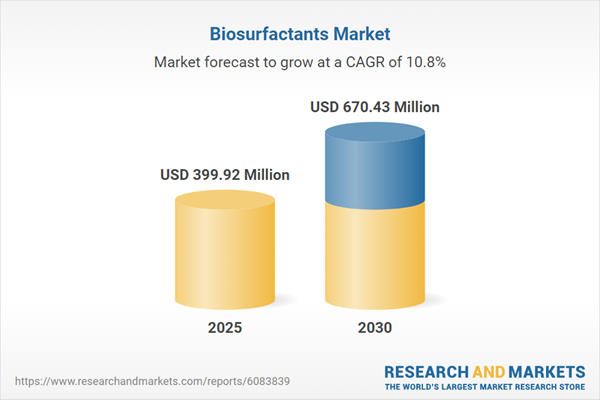Speak directly to the analyst to clarify any post sales queries you may have.
The biosurfactants market is undergoing profound transformation as industries seek efficient, eco-friendly alternatives to traditional surfactants. Senior leaders are closely monitoring this dynamic shift, driven by innovation, regulatory demands, and the strategic pursuit of sustainability.
Market Snapshot: Biosurfactants Market Size, Growth, and Key Dynamics
The biosurfactants market grew from USD 362.34 million in 2024 to USD 399.92 million in 2025. It is projected to register a CAGR of 10.79%, reaching USD 670.43 million by 2030. High demand is propelled by industries seeking solutions that meet evolving environmental regulations and deliver on both performance and sustainability. Fuelled by their biodegradability and minimal eco-toxicity, biosurfactants are increasingly recognized for enabling cleaner processes while helping businesses transition toward a circular economy.
Scope & Segmentation: Strategic Coverage of the Biosurfactants Market
This comprehensive report details key segments, regional opportunities, and advances in technology, enabling executive teams to align decisions with emerging market realities.
- Type: Glycolipids (Rhamnolipids, Sophorolipids), Lipopeptides (Iturin, Surfactin), Polymeric (Alasan, Emulsan)
- Source: Animal-Based Biosurfactants, Microbial Biosurfactants, Plant-Derived Biosurfactants
- Distribution Channel: Offline, Online
- Application: Agricultural Chemicals, Cosmetics & Personal Care, Food Processing, Household Detergents, Industrial & Institutional Cleaners, Oilfield Chemicals, Pharmaceutical, Textiles
- Regions: Americas (North America: United States, Canada, Mexico; Latin America: Brazil, Argentina, Chile, Colombia, Peru), Europe, Middle East & Africa (Europe: United Kingdom, Germany, France, Russia, Italy, Spain, Netherlands, Sweden, Poland, Switzerland; Middle East: United Arab Emirates, Saudi Arabia, Qatar, Turkey, Israel; Africa: South Africa, Nigeria, Egypt, Kenya), Asia-Pacific (China, India, Japan, Australia, South Korea, Indonesia, Thailand, Malaysia, Singapore, Taiwan)
- Companies: AGAE Technologies, Allied Carbon Solutions, Arkema Group, BASF, Biosurfactants LLC, Biosynth, Biotensidon GmbH, Boruta-Zachem SA, Clariant, Croda International, Dispersa, Ecover, Evonik, Geocon Products, Givaudan, GlycoSurf, Holiferm, Indorama Ventures, Jeneil Biotech, Kao, Lankem, Locus Performance Ingredients, Merck, Pilot Chemical, Saraya, Sasol, Shell, Sironix Renewables, Stepan, Syensqo, Dow, Lubrizol, Unilever
Key Takeaways: Strategic Insights for Senior Decision-Makers
- Biosurfactants offer robust performance while aligning with the key principles of circular economy and reduced environmental footprints.
- Production harnesses fermentation and bioprocessing to convert diverse feedstocks into high-value surface-active compounds, reducing waste streams.
- Emerging product types—glycolipids, lipopeptides, and polymeric biosurfactants—address differing market needs, from antimicrobial activity in personal care to stabilization in industrial settings.
- Collaborations across biotechnology, chemical engineering, and sustainability sectors are accelerating the pace of innovation and commercialization.
- Digitalization and advanced analytics ensure greater efficiency and product consistency, supporting scalable, cost-effective manufacturing processes.
- Adoption is rising across expanded distribution channels, with digital platforms enabling greater market reach and direct engagement with end-users.
Tariff Impact: Navigating 2025 Trade Policy Shifts
Revised U.S. tariffs on biosurfactant precursors in 2025 have triggered manufacturers to reassess and realign their global sourcing and supply chain strategies. In response, many industry leaders are investing in local production and nearshoring, bolstering their supply resilience and mitigating risks associated with fluctuating tariffs. These market adaptations also reflect a transition toward in-country manufacturing and greater agility in resource planning.
Methodology & Data Sources
Findings are built on rigorous secondary research and direct interviews with more than twenty industry experts. Analytical methods include advanced data triangulation, regression modeling, and validation workshops to ensure impartial and actionable insights for senior leadership teams.
Why This Report Matters for Senior Leaders
- Identify high-impact opportunities by understanding segmentation, innovation trends, and regional regulations in the biosurfactants market.
- Guide strategic investments with early insight into evolving regulatory frameworks, technology adoption, and channel developments.
- Strengthen organizational preparedness with recommendations that support sustainability, digital transformation, and resilient supply chains.
Conclusion
This report arms decision-makers with critical intelligence on biosurfactant market evolution, spotlighting growth drivers, leading players, and actionable strategies. With targeted insights, organizations can navigate industry change, optimize resource allocation, and drive long-term sustainable value.
Table of Contents
3. Executive Summary
4. Market Overview
7. Cumulative Impact of Artificial Intelligence 2025
Companies Mentioned
The companies profiled in this Biosurfactants market report include:- AGAE Technologies, LLC
- Allied Carbon Solutions Co., Ltd.
- Arkema Group
- BASF SE
- Biosurfactants LLC
- Biosynth Ltd.
- Biotensidon GmbH
- Boruta-Zachem SA
- Clariant AG
- Croda International PLC
- Dispersa Inc.
- Ecover
- Evonik Industries AG
- Geocon Products
- Givaudan SA
- GlycoSurf, Inc.
- Holiferm
- Indorama Ventures Public Company Limited
- Jeneil Biotech Inc.
- Kao Corporation
- Lankem Ltd.
- Locus Performance Ingredients
- Merck KGaA
- Pilot Chemical Company
- Saraya Co. Ltd.
- Sasol Limited
- Shell PLC
- Sironix Renewables
- Stepan Company
- Syensqo
- The Dow Chemical Company
- The Lubrizol Corporation
- Unilever PLC
Table Information
| Report Attribute | Details |
|---|---|
| No. of Pages | 184 |
| Published | November 2025 |
| Forecast Period | 2025 - 2030 |
| Estimated Market Value ( USD | $ 399.92 Million |
| Forecasted Market Value ( USD | $ 670.43 Million |
| Compound Annual Growth Rate | 10.7% |
| Regions Covered | Global |
| No. of Companies Mentioned | 34 |









